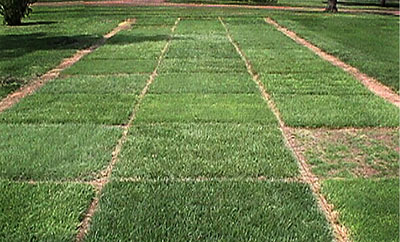Guide H-508
Bernd Leinauer
College of Agricultural, Consumer, and Environmental Sciences, New Mexico State University.
Author: Extension Turfgrass Specialist, Department of Extension Plant Sciences, New Mexico State University. (Print friendly PDF)
Introduction
An important aspect of obtaining a good turfgrass stand is to select the correct or best adapted species and variety. Certain turf characteristics, such as climate adaptation, water use, traffic tolerance, color, quality, maintenance requirements, and available resources, are all factors that need to be considered when selecting a turf species (Figure 1). Climatic adaptation and traffic tolerance, which largely determine the future use of the turf area, are the two most important factors. Many problems encountered in maintaining turfs can be attributed directly to selecting the wrong turfgrasses for New Mexico’s difficult climatic conditions and to the lack of resources, especially water, that homeowners and professional turf growers face in the state.

Figure 1. A turfgrass research plot in which different turfgrass varieties are evaluated.
Climatic Adaptation in New Mexico
Turfgrasses can be divided into two major groups: the cool-season and the warm-season grasses. Cool-season grasses include perennial ryegrass, Kentucky bluegrass, fine fescues, creeping bentgrass, and tall fescue. Optimal growth of these grasses occurs within a temperature range of 60° to 70°F, and they require more water than warm-season grasses. Warm-season grasses, such as bermudagrass, buffalograss, blue grama, St. Augustinegrass, and zoysiagrass, grow best at temperatures between 80° and 95°F and use water more efficiently. Because of their optimal growth rate at lower temperatures, cool-season turfgrasses are generally adapted to temperate and subarctic climates, while warm-season grasses grow best in arid, semiarid, tropical, and subtropical zones.
In New Mexico, cool-season grasses generally can be used anywhere north of Socorro, including the Cloudcroft, Ruidoso, and Silver City areas, while warm-season grasses are more adapted to the southern part of the state. However, this general rule oversimplifies the situation. In most parts of the state the climate is semiarid, and daily seasonal temperatures can fluctuate widely due to the high altitude. This creates a dilemma about which turfgrass species are the most suitable. The climate is semiarid with low precipitation, suggesting that warm-season grasses are more appropriate. But low temperatures due to high elevations, particularly in the winter, make cool-season grasses the better choice. Because of the cool fall, winter, and spring and relatively cool summer nights, cool-season grasses can be grown successfully almost anywhere in New Mexico under regular irrigation conditions. If water consumption is a concern, the lack of sufficient precipitation makes warm-season grasses the better choice. With the introduction of improved cold tolerant warm-season grasses, New Mexicans can grow low-water-use, warm-season grasses almost anywhere in the state without losing the grasses to winter kill. However, regardless of this low temperature tolerance, warm-season grasses will go dormant and lose their color for at least five months of the year and will not provide the aesthetic benefit that residents may look for.
Warm-Season Grasses
Bermudagrass
Bermudagrass is the species most adapted to and most frequently used in the lower elevations of southern New Mexico. Many new and improved seeded varieties have been developed and released during the last 15 years. Users now have a choice of varieties that are denser and finer textured than the common bermudagrass. Bermudagrass spreads aggressively by stolons (aboveground runners) and rhizomes (belowground runners) and can become a nuisance when it invades flower beds and gardens. Also, cold-tolerant seeded and vegetative varieties are available that withstand lower winter temperatures.
Buffalograss
Buffalograss is more drought-tolerant and can be sustained on similar water levels to bermudagrass. Improved seeded buffalograsses are now available. They are denser and of higher quality (more attractive) than the older, dual-purpose forage varieties, yet not as dense as traditional lawn grasses. Special care must be taken during establishment, especially in weed control.
Zoysiagrass
Improved zoysiagrass varieties have been introduced that establish more quickly than previous varieties. However, zoysiagrass still establishes slower than bermudagrass. The newer varieties are very dense and can be grown successfully even in the cooler areas of New Mexico.
Cool-Season Grasses
Perennial ryegrass
Improved and newly released varieties of perennial ryegrass are well adapted to most of New Mexico, and thus their use has increased greatly. These varieties establish quickly and provide good cold tolerance and winter color. Newer varieties also come with better heat tolerance and can survive summers even in southern New Mexico.
Kentucky bluegrass
Historically, the use of Kentucky bluegrass was limited to the cooler parts of New Mexico. Unlike perennial ryegrass, which is a bunch type turfgrass, Kentucky bluegrass spreads by rhizomes and withstands moderate traffic. Because of the rhizomes, Kentucky bluegrass recuperates well from wear injury or heat stress. On athletic fields, it can be used in mixtures with perennial ryegrass and/or tall fescue. Similar to perennial ryegrass, newer Kentucky bluegrass varieties come with greater heat tolerance and reduced irrigation requirements, making it suitable for all of New Mexico.
Tall fescue
Due to its heat and drought tolerance, tall fescue is a good general-purpose turfgrass for New Mexico. It is a tall-growing, coarse- to medium-textured, bunch-type turfgrass that can be established by seed or sod. Tall fescue resists heavy wear and high temperatures. When adequately irrigated, it can be grown successfully in all areas of New Mexico. In warmer areas in the south, a tall fescue stand can be weakened and can deteriorate through the invasion of bermudagrass.
Traffic Tolerance and Recuperative Ability
If turf areas have intensive traffic (athletic fields, some home lawns), select varieties that have adequate wear tolerance and the capacity to recover quickly from injury (Table 1). Although tall fescue is one of the most wear-resistant cool-season turfgrass, it may not be suitable for many sports turf areas because it is poorly adapted to low mowing heights. Kentucky bluegrass and perennial ryegrass both have adequate wear resistance and are equally suited to high-traffic areas. Among the warm-season grasses, bermudagrass and zoysiagrass have excellent wear resistance. Only bermudagrass, however, has excellent recuperative capacity. Zoysiagrasses recover very slowly from injury. Table 1 provides a quick reference to species adaptation, traffic tolerance, and recuperative ability.
Table 1. Turfgrasses for New Mexico
|
Grasses |
Grass type* |
Growing areas in New Mexico** |
Traffic tolerance |
Recuperative capability |
|
Creeping Bentgrass |
C |
N, S |
Low |
High |
|
Bermudagrass |
W |
S |
High |
High |
|
Blue Grama |
W |
S |
Low |
Low |
|
Buffalograss |
W |
N, S |
Medium |
Low |
|
Fine Fescue |
C |
N, S |
Medium |
Medium |
|
Kentucky Bluegrass |
C |
N |
Medium/High |
Medium |
|
Perennial Ryegrass |
C |
N, S |
High |
High |
|
St. Augustinegrass |
W |
S |
Low |
Low |
|
Tall Fescue |
C |
N, S |
High |
Medium |
|
Zoysiagrass |
W |
N, S |
High |
Low |
|
*C: cool-season grass, W: warm-season grass |
||||
Blue grama, St. Augustinegrass, seashore paspalum, and other warm-season grasses may be available in certain areas of New Mexico as seed and/or sod. New turfgrasses, such as Texas bluegrass (Reveille), supina bluegrass, and crested hairgrass (turtle-turf), have also been introduced to the turf market but have not been tested sufficiently under New Mexico’s climatic conditions. These grasses have special advantages and require special care during establishment. Contact your local county Extension agent (aces.nmsu.edu/county/) or seed dealer for more information.
For Further Reading
Circular 660: Turfgrass Irrigation
https://pubs.nmsu.edu_circulars/CR660/
H-505: Mowing Your Lawn
https://pubs.nmsu.edu/_h/H505/
H-507: Lawn Care for Disease Control
https://pubs.nmsu.edu/_h/H507/
H-510: How to Perform a Catch Can Irrigation Audit on a Home Lawn Sprinkler System
https://pubs.nmsu.edu/_h/H510/
| Original authors: Bernd Leinauer, Extension Turfgrass Specialist; and Arden Baltensperger, Professor Emeritus. |
In Memoriam

Dr. Arden Baltensperger passed away on October 6, 2015, at the age of 95. While a professor at NMSU, he developed several seeded bermudagrass varieties, of which NuMex Sahara and Princess 77 have been used with great success in semiarid and arid locations worldwide. Without his varieties, growing turf would not have been possible in these locations. His legacy lives on with these grasses.

Bernd Leinauer is a professor and Extension Turfgrass Specialist in the Department of Extension Plant Sciences. He received his M.S. and Ph.D. degrees in crop and soil science from Hohenheim University in Stuttgart, Germany. His Extension and research program focuses on developing water management strategies for turf areas to reduce the amount of water used for irrigation.
To find more resources for your business, home, or family, visit the College of Agricultural, Consumer and Environmental Sciences on the World Wide Web at pubs.nmsu.edu
Contents of publications may be freely reproduced for educational purposes. All other rights reserved. For permission to use publications for other purposes, contact pubs@nmsu.edu or the authors listed on the publication.
New Mexico State University is an equal opportunity/affirmative action employer and educator. NMSU and the U.S. Department of Agriculture cooperating.
Revised July 2016 Las Cruces, NM


